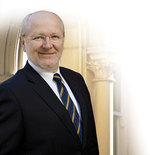A change of seasons
 Vice-Chancellor Vice-Chancellor
At this time of year, as the North Terrace Campus changes colour, the autumn season seems to accentuate the University's sandstone history and nearly 135 years of tradition. As students and staff make their way to and from classes, on the crisp but sunny mornings, it is easy to take for granted the rich heritage that has shaped our great institution. This sense of tradition has been all the more pertinent as students, adorned in academic dress, gathered at one of the many graduation ceremonies held in Bonython Hall in April. The sense of grand occasion and achievement was almost palpable. The same sentiment was just as evident as nearly 200 students graduated from the University's Ngee Ann-Adelaide Education Centre in Singapore last month. Graduation ceremonies remind us, as the students leave our surrounds, of the reasons that brought them to the University in the beginning. Those reasons will ultimately help to make our community all the better from the impact of their education. In Australia, we have 39 universities with each one playing a specific and valuable role in guiding the individual student towards their aspirations and realisation of their full potential. Lately there has been public interest in how the three universities in South Australia work together, in both teaching and research. The relocation of the Royal Adelaide Hospital to the West End, and the subsequent need for us to move our Medical School to the same precinct, sparked broader discussion of mergers and collaborations. And, as with any change at the helm, there is invariably speculation on future directions. This is an old chestnut that seems to resurface every once in a while. Of course, universities and research entities will always benefit from networks and joint ventures. Indeed, some of our most outstanding achievements, across all areas of research, have been driven through partnerships with different local, national and international organisations. In this regard, the University of Adelaide will continue to work collaboratively with the University of South Australia, Flinders University and many others, across a range of areas - exactly as we have done for many years. However, the different universities each enjoy distinct features, and unique positions within our community. This is very important in ensuring a broad educational offering is readily available to both local and international students. Sometimes the real strength of a higher education community is found quite simply in a shared contribution to a greater goal of community enrichment. PROFESSOR JAMES A. McWHA
Vice-Chancellor and President
|





